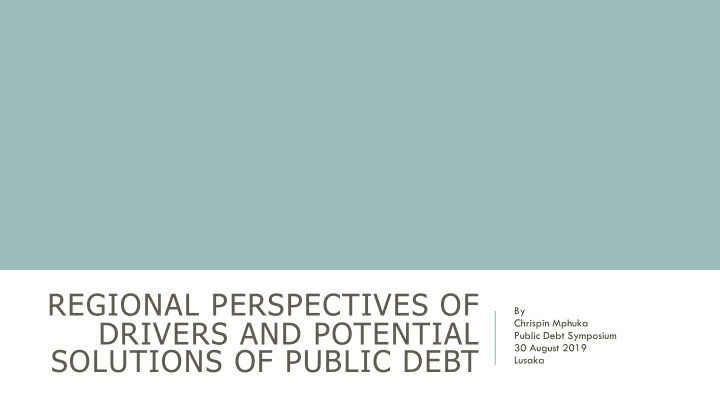



REGIONAL PERSPECTIVES OF By DRIVERS AND POTENTIAL Chrispin Mphuka Public Debt Symposium 30 August 2019 SOLUTIONS OF PUBLIC DEBT Lusaka
OUTLINE Introduction Sub- Saharan Africa’s Debt Situation after Debt Relief Drivers of Rising Debt in Africa Historical Perspective Current causes What can be done for Africa to avoid debt crisis Conclusion
INTRODUCTION Increasing concerns, due to rising debt levels, have been raised on the looming debt crisis in Africa. As of 2017, 19 African countries had exceeded the 60% debt-to-GDP threshold set by the African Monetary Co-operation Program (AMCP) While 24 countries had surpassed the 55% debt-to-GDP ratio suggested by the IMF. As at 31 July 2019, the IMF reports that 37% of Sub-Saharan countries are either in debt distress or in risk of debt distress. Within the Southern Africa region, Mozambique and Zimbabwe are in debt distress already while Zambia is in high risk of debt distress. Rising domestic borrowing crowding out private sector and dampening economic growth
INTRODUCTION According to Coulibary et al. (2019): A higher share of debt is now commercial debt Consequently, this has caused debt servicing costs to increase rapidly. Interest cost as a share of government revenues doubled from 5 percent in 2012 to 10 percent in 2017. Interest cost increase has been particularly large in Angola, Nigeria, Ghana, and Burundi, rising by almost 20 percentage points. As a result, interest costs now account for 10 percent of government revenues in 17 countries, compared with six countries in 2012.
SUB- SAHARAN AFRICA’S DEBT SITUATION AFTER DEBT RELIEF (GENERAL DEBT AS % OF GDP)
SUB- SAHARAN AFRICA’S DEBT SITUATION AFTER DEBT RELIEF ( IMF 2018 REGIONAL ECONOMIC OUTLOOK)
DRIVERS OF RISING DEBT IN AFRICA : A HISTORICAL PERSPECTIVE According to Onyekwena and Ekeruche (2019): Africa’s debt crisis of the 1980s and 90s started in the 1960s from a public spending spree by newly independent countries to stimulate their economies through rapid investment in industry and infrastructure Commodity booms and heavy use of external debt supported this spending as policy leaders relied on future export earnings and economic growth to improve the capacity to service the debt Notably, those countries did not reduce expenditures during negative commodity shocks and instead took on more loans.
Source: Onyekwena and Ekeruche (2019)
DRIVERS OF RISING DEBT IN AFRICA : A HISTORICAL PERSPECTIVE A summary of main causes of the debt crisis of the 1980s and 1990s I. The global recession of the 1980s II. The decline in net capital inflows into African countries due to negative real interest rates III.The rise in interest rates in developed countries IV.Failure to abandon expansionary fiscal policies when exports and economic growth declined
Drivers of Rising Debt in Africa Current causes are they any different from the past? Increased investment in infrastructure spending to meet the infrastructure deficit (but also driven by political appeasement (Problem is benefits of debt- immediate but costs in future! ) The rise in Chinese lending to Africa that has no governance conditionality on lending. China committed $125 billion in loans to sub-Saharan African countries between 2000 and 2017 . Chinese lending to the region has accelerated since 2012 to about $10 billion every year from an average of $5 billion between 2005 and 2010. Availability of commercial lending: Most countries have raised Euro-bonds e.g. Ethiopia, Kenya, Ghana, Zambia etc. The share of private lending to Africa has risen from 9 percent of external debt in 2000 to 17 percent in 2017.
DRIVERS OF RISING DEBT IN AFRICA Counter-cyclical spending to stimulate economy during the global recession of 2008 Poor governance: Lack of transparent clear simple rules on when, what and from whom to borrow! Lack of fiscal rules. E.g. Mozambique and hidden debts Exchange rate depreciation e.g. in Zambia where the exchange rate depreciated and payments have had a negative effect on debt repayments Declining growth driven by commodity price shocks (Africa still mostly commodity dependent)
WHAT CAN BE DONE FOR AFRICA TO AVOID ANOTHER DEBT CRISIS Increasing domestic resource mobilization Concerted efforts towards curtailing illicit financial transfers Accelerating structural transformation to move away from dependency on commodities Credible austerity measures ( to include scaling down infrastructure projects)
WHAT CAN BE DONE TO FOR AFRICA TO ANOTHER AVOID DEBT CRISIS Transparency and accountability in debt management: Need for regular comprehensive debt reports a necessity) there should be no room for hidden debts! The fight against corruption is indeed a fight to ensure dampened appetite for debt procurement! If debt is financing corrupt projects then we have a big problem. Project appraisal to assure value for money and quality of projects. Implementing legally binding fiscal rules that will guide when and how much to borrow. These can even have a punitive measures.
CONCLUSION: Public debt has now climbed above 50% of Gross Domestic Product (GDP) in nearly half of the countries in sub-Saharan Africa. We are not yet at pre-HIPC levels of debt but the concern is that the debt is rising at a faster rate than before The fact that debt is now either commercial (by private banks and bond holders) or bilateral casts serious doubt if another debt relief can happen Fiscal rules rather than discretion in debt contracting process will help in controlling the debt process.
WORKS CITED Samira , J (2015) Borrowng Responsibly : Africa’s Debt Challenge https://www.un.org/africarenewal/magazine/august-2015/borrowing-responsibly-africa%E2%80%99s-debt- challenge Coulibary , B.S. Ghandi, D and Senbet, L.W (2019) Is Sub-Saharan Africa Facing Another Systemic Sovereign Debt Crisis? Brookings Policy Brief https://www.un.org/africarenewal/magazine/august-2015/borrowing-responsibly- africa%E2%80%99s-debt-challenge Onyekwena, C. and Ekeruche, M.A (2019) Is a Debt Crisis Looming in Africa Centre for the Study of Economies of African Brookings Policy Paper https://www.brookings.edu/blog/africa-in-focus/2019/04/10/is-a-debt-crisis- looming-in-africa/
THE END THANK YOU FOR YOUR ATTENTION
Recommend
More recommend